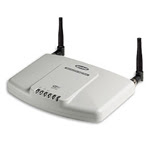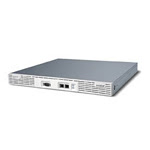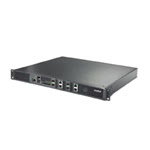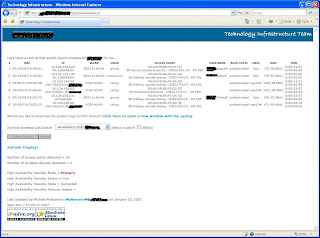 I’ve worked primarily with Motorola (formerly Symbol) since the early 802.11b FHSS (Frequency Hopping Spread Spectrum) days. When 802.11b DSSS (Direct Sequence Spread Spectrum) came to the forefront I worked with the Symbol 4121/4131 Access Points (some of which were OEM’d for Nortel Networks at the time). The Access Points were very versatile and had a very extensive SNMP mib. I was able to write several Perl scripts to help manage the large number of Access Points that we had deployed at numerous locations and facilities.
I’ve worked primarily with Motorola (formerly Symbol) since the early 802.11b FHSS (Frequency Hopping Spread Spectrum) days. When 802.11b DSSS (Direct Sequence Spread Spectrum) came to the forefront I worked with the Symbol 4121/4131 Access Points (some of which were OEM’d for Nortel Networks at the time). The Access Points were very versatile and had a very extensive SNMP mib. I was able to write several Perl scripts to help manage the large number of Access Points that we had deployed at numerous locations and facilities.
Symbol was th e industry’s first company to design a switched-wireless networking architecture, pioneering the thin or lightweight Access Points (or Access Ports as they would come to be known as). The Symbol WS5000 Wireless LAN Switch was driven by LynuxWorks operating system. Later software releases of the WS5000 and later the WS5100 would use an internally developed version of Linux (I know their using Linux I’m just not 100% sure who’s developing it for them). The primary wireless design constraint with the Motorola WS5100 is the maximum 48 port Access Port adoption limit. The hardware can only support 48 simultaneous Access Ports in a single switch. At one hospital we have over 200 Access Ports and over 18 WS5100s deployed, 9 primary WS5100s and 9 standby WS5100s .
e industry’s first company to design a switched-wireless networking architecture, pioneering the thin or lightweight Access Points (or Access Ports as they would come to be known as). The Symbol WS5000 Wireless LAN Switch was driven by LynuxWorks operating system. Later software releases of the WS5000 and later the WS5100 would use an internally developed version of Linux (I know their using Linux I’m just not 100% sure who’s developing it for them). The primary wireless design constraint with the Motorola WS5100 is the maximum 48 port Access Port adoption limit. The hardware can only support 48 simultaneous Access Ports in a single switch. At one hospital we have over 200 Access Ports and over 18 WS5100s deployed, 9 primary WS5100s and 9 standby WS5100s .
 Motorola has just recently released the RFS7000 Wireless LAN Switch that promises to support up to 256 Access Ports. I won’t go into all the features, I’ll let you find that out from Motorola’s web site. Motorola’s recent Wi-NG software release (v3.x) also offers clustering options allowing around 2,500 Access Ports within a single cluster. In previous releases you needed to have a primary and standby WS51000 for every switch, with clustering you can now have N+1 redundancy within the cluster. The new software also sports a very Cisco like command line interface which is great step up from the previous CLI interface in their v2.x software release. Network administrators will also be happy to know that the same version of software will now run on all “Motorola Wireless LAN Infrastructure”, including the WS2000, WS5100, RFS7000 and AP5131. I’ve worked with all three types of thin Access Ports currently available from Motorola; the AP100 (802.11b), the Ap200 (802.11a/b), and the latest AP300 (802.11a/b/g). We’ve deployed these Access Ports using Nortel ES460, ERS5520 switches providing Power over Ethernet (PoE).
Motorola has just recently released the RFS7000 Wireless LAN Switch that promises to support up to 256 Access Ports. I won’t go into all the features, I’ll let you find that out from Motorola’s web site. Motorola’s recent Wi-NG software release (v3.x) also offers clustering options allowing around 2,500 Access Ports within a single cluster. In previous releases you needed to have a primary and standby WS51000 for every switch, with clustering you can now have N+1 redundancy within the cluster. The new software also sports a very Cisco like command line interface which is great step up from the previous CLI interface in their v2.x software release. Network administrators will also be happy to know that the same version of software will now run on all “Motorola Wireless LAN Infrastructure”, including the WS2000, WS5100, RFS7000 and AP5131. I’ve worked with all three types of thin Access Ports currently available from Motorola; the AP100 (802.11b), the Ap200 (802.11a/b), and the latest AP300 (802.11a/b/g). We’ve deployed these Access Ports using Nortel ES460, ERS5520 switches providing Power over Ethernet (PoE).
 The web based console on the early (v2.x software) releases was a Java based application that was horrible to work with from a configuration and troubleshooting perspective. It was slow and would continually crash and lockup. In order to alleviate this problem I wrote a web based application so our network engineers and help desk could monitor the wireless network without having to launch the Java application. I wrote the application in Perl at the time because that was the language I was most familiar with and the most comfortable. The application uses SNMP to query the wireless LAN switch and then outputs the data to the user.
The web based console on the early (v2.x software) releases was a Java based application that was horrible to work with from a configuration and troubleshooting perspective. It was slow and would continually crash and lockup. In order to alleviate this problem I wrote a web based application so our network engineers and help desk could monitor the wireless network without having to launch the Java application. I wrote the application in Perl at the time because that was the language I was most familiar with and the most comfortable. The application uses SNMP to query the wireless LAN switch and then outputs the data to the user.
You can find the source code along with some additional details on my website under the Perl section. The application will only work against v2.x software releases. Motorola completely re-designed their software in their v3.x software release along with the associated SNMP mibs.
I just recently started looking a Meru Networks as an alternative solution to Motorola.